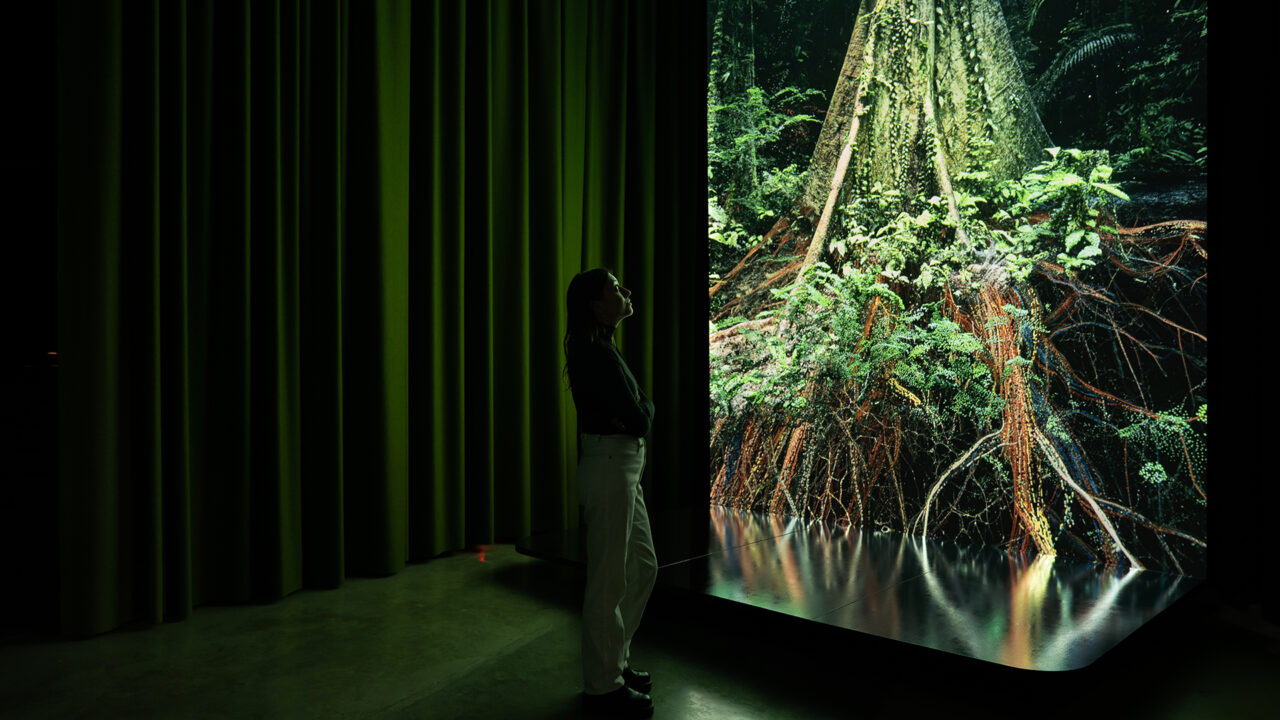- Posted on August 29th, 2023
Our Time on Earth at the Barbican

Our Time on Earth is a major immersive exhibition exploring radical ideas around the climate crisis. Commissioned and curated by the Barbican with Guest Curators FranklinTill and co-produced by Musée de la civilisation, Québec City, Canada, Our Time on Earth was presented at the Barbican Centre from 5th May to 29th August 2022, and is now touring internationally, beginning in North America.
Bringing together 18 ecologically committed practitioners and collectives and 12 new commissions spanning art, design, science, and activism, Our Time on Earth is an important example of how an innovative team can present a climate-focused exhibition that demonstrates strong environmental values and vision throughout the exhibition-making process.
A pioneering institution that places environmental action at the heart of its exhibition production
The approach taken by the Barbican Immersive team is pioneering work in the sustainable production of visual arts exhibitions. The team has successfully embraced ideas of sustainability and connection to the natural world at every stage of development, embedding climate action from planning to delivery, and should be considered an early adopter of best practice in the field.
Sustainability in the design phase
This green commitment began at an early stage, with the Barbican and Guest Curators Franklin Till developing a Sustainability Manifesto shared with all stakeholders (designers, artists, exhibitors, suppliers, extended team, transport companies, etc.). It included sustainability criteria in the designers brief and suppliers’ selection.
Indeed, recognising that the biggest impact occurs at the design phase, this forward-thinking attitude is essential to reducing carbon emissions and waste. Other leading museums should be encouraged to anticipate potential sources of CO2 and unnecessary waste, and to engage in early discussions with key stakeholders and partners to make each stage of the exhibition process more sustainable.
Data collection for quantifying impacts and review
Our Time on Earth was the first exhibition at the Barbican where the environmental footprint was actively measured and quantified. Environmental impact indicators covered energy, resource use, waste, water and transport to quantify impacts and record positive environmental decisions to identify problem areas for improvement and set targets for future exhibitions.

Sustainability in the production and construction process
After the design phase, green approaches continued to be discussed during the production and construction process. Circular economy principles were adopted, as well as modular design, considering longevity as criteria. The exhibition team prioritised the use of reused or recycled materials wherever possible, and ensured that circularity and end-of-life were considered when using virgin material. They also considered sustainability in the printing of the catalogue, which involved environmental credentials of the printers, new approaches to binding and the use of algae link, as well as high percentage of recycled content in the selection of the paper.
Sustainable touring
Our Time on Earth is a touring exhibition that will travel by boat to the Musée de la civilisation* in Quebec City, Canada, and then by road to Peabody Essex Museum in Massachusetts, USA. To this end, the Barbican has developed partnerships with selected transport companies to monitor its impact and collect travel data.
All these combined efforts should help the Barbican to achieve its targets of Net Zero by 2027 for its direct emissions (Scope 1 and 2) and by 2040 for its indirect emissions (Scope 3), in line with the City of London Corporation.
These are just a few examples of how the Barbican has implemented environmental actions throughout the decision-making process of Our Time on Earth. To find out more, please contact Luke Kemp or Chloe Wood at the Barbican.
Julie’s Bicycle — Creative Green Consultancy
The Barbican commissioned Julie’s Bicycle to produce a carbon impact report of some key areas of interest from the exhibition Our Time on Earth, presented from 5th May to 29th August 2022 at the Barbican Centre.
Some of the areas of carbon footprint data reviewed included:
- Materials used from an individual exhibit, ‘The Ideal City.’
- Overall materials used
- Use of audio-visual equipment
- Transport of team, materials and artwork
Julie’s Bicycle also helped develop a strategy to measure environmental impact throughout all exhibition stages and calculated carbon footprints as g/kg/tonnes of CO2e (CO2 equivalent) of specific areas of the exhibition.
*The exhibition will run at the Musée de la civilisation in Quebec City, Canada, from 15 June to 7 January 2024, and then at Peabody Essex Museum, Massechusetts, from 17 February – 9 June 2024
Header photo credit: Marshmallow Laser Feast – Sanctuary of the Unseen Forest, 2022 Courtesy of MLF and Sandra Ciampone

